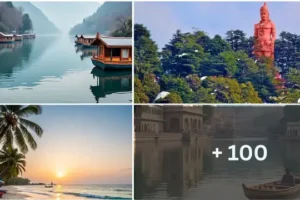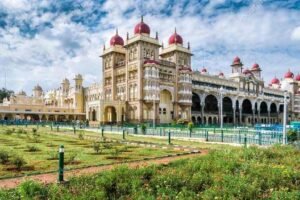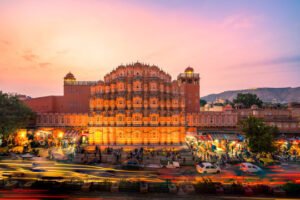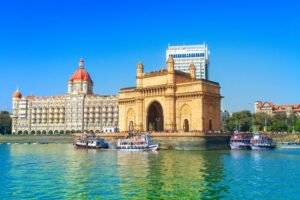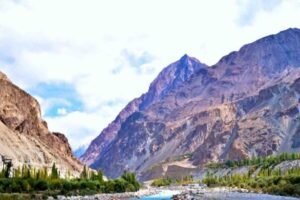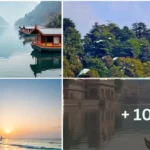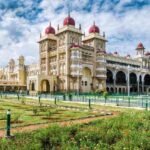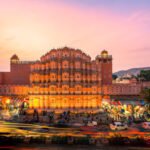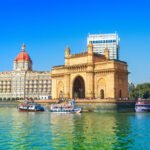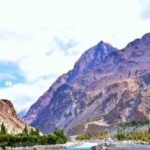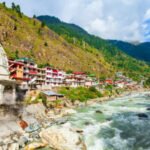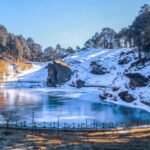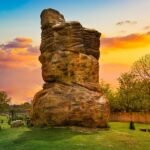Kangra Fort The Ancient Castle Amidst Mountains
Kangra Fort Himachal Pradesh, Best Things You Need to Know 2024: The Kangra Fort was built by the royal Rajput family of Kangra State (the Katoch dynasty), which traces its origins to the ancient Trigarta Kingdom, mentioned in the Mahabharata epic. It is the largest fort in the Himalayas and probably the oldest dated fort in India.

The Kangra Fort, also known as Nagarkot and Kot Kangra, is a historic fort located in the Kangra. The fort’s origins are believed to date back to the ancient Trigarta Kingdom, which is mentioned in the Mahabharata epic. It is said that the fort was built by Maharaja Susharma Chandra of the Katoch dynasty around 3500 years ago. The fort has a long and tumultuous history, having been invaded by numerous rulers and empires over the centuries, including Mahmud Ghazni, Firuz Shah Tughluq, and Sher Shah Suri.
Best Things You Need to Know 2024
Kangra Fort: The Heritage of Katoch Dynasty
Origins and Early Remains:
- The fort was built by the Katoch Dynasty of the Rajputs, which traces its origins to the ancient Trigarta Kingdom mentioned in the Mahabharata epic.
- The earliest existing remains inside the fort include Jain and Brahminical temples dating back to the 9th-10th century A.D.1.
Early Invaders:
- The fort’s strategic location made it a prime target. Mahmud of Ghazni plundered the Kangra Fort in 1009 AD, followed by attacks from the Delhi Sultanate in the 14th century.
- In 1540 A.D., Khawas Khan Marwat, a superior general of Sher Shah Suri, managed to capture the fort.
Emperor Jahangir visited the fort in 1621 and ordered the slaughter of a bullock there. A mosque was also built within the fort during this time.
Mughal Rule and Sikh Influence:
- The 16th century saw Mughal emperors Akbar and Jahangir conquer the fort, further solidifying its importance.
- Raja Sansar Chand II, a descendant of Raja Dharam Chand, eventually gained control of the fort through a peaceful treaty with Jai Singh Kanhaiya, a Sikh leader of the Kanhaiya Misl.
- Raja Sansar Chand expanded his kingdom by conquering nearby regions such as Chamba, Mandi, Suket, and Nahan.
- The British East India Company finally captured the fort in 1846 after a prolonged siege. A devastating earthquake in 1905 caused significant damage to the structure.
Legacy of Kangra Fort:
- The Archaeological Survey of India currently maintains the fort, which stands as a testament to the region’s rich history.
- The Kangra Fort remains a testament to its rich history, resisting invasions and witnessing the rise and fall of various dynasties over centuries.
Structural Marvel with Military Smarts
Strategic Location:
- The fort is perched on a precipitous ridge, strategically positioned between the Manjhi and Banganga rivers.
- Built on a hillock meeting two rivers.
- Commanded a view of the surrounding valley, offering a tactical advantage.
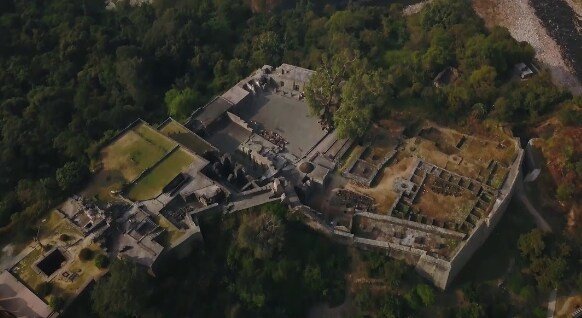
Architectural Blend Layout:
- Constructed with local stone and clay, some sections reaching impressive thicknesses (up to 4 meters) and heights (up to 20 meters).
- The fort covers an area of approximately 4 square kilometers and sprawls across the hill.
- The fort has several gates that controlled access.
- Courtyards within offered additional defensive layers and could be compartmentalized if breached.
- Several watchtowers allowed guards to keep a vigilant eye on the surroundings.
- The fort’s grounds likely featured gardens and green spaces.
Historical Significance:
- The Kangra Fort is the oldest fort in India and has witnessed numerous invasions by various rulers.
- Legends connect the Katoch dynasty, which ruled the fort, to mythological events like the battle between Goddess Ambika and the demon Raktbeej.
- The Katoch dynasty’s roots trace back to Bhumi Chand, who assisted the goddess in defeating the demon and received the kingdom of Trigarta (including Kangra) as a reward.
Legacy and Treasures:
- Local legends speak of 21 treasure wells within the fort complex.
- While their existence and contents are not confirmed, they add to the mystique of the fort.
- The fort’s layered history, political legacy, and architectural marvel provide a glimpse into ancient India’s glory.
- Over time, it has been under the control of Greeks, Kings of Kashmir, Afghans, Tughlaqs, Mughals, Gorkhas, Sikhs, and the British.
- Its enduring significance is captured in the Pahadi saying: “He who holds the Kangra fort, holds the hills.”
How to Reach Kangra Fort
The Kangra Fort is situated approximately 20 kilometers from the town of Dharamsala, on the outskirts of Kangra town. It stands atop a hillock between two rivers, the Manjhi and Banganga, nestled among the foothills of the Dhauladhar range.
By Air:
- The closest airport to Kangra Fort is Kangra Airport, Gaggal, which is approximately 14 kilometers away. You can book a prepaid taxi from the airport to the fort.
By Bus:
- Direct buses are available from major cities like Delhi to Kangra. You can also take a bus to Dharamshala and then hire an auto-rickshaw or taxi to reach the fort.
By Road:
- Kangra Fort is well connected by roads to major cities in Himachal Pradesh and North India. You can either hire a taxi or take your car to reach the fort.
Important Travel Tips:
- Wear comfortable shoes, as there is some walking involved within the fort.
- Carry water and sunscreen, especially during sunny days.
- Explore the various gates, temples, and the Kangra Fort Palace Courtyard.
- INR 150 for Indians with Audio Guide.
- INR 300 for Foreigners with Audio Guide.
- Timings: 9 AM to 5.30 PM from Monday to Sunday
Best Time to Visit
The ideal time to explore Kangra Fort is during the spring and autumn months (March to June and September to November) when the weather is pleasant.
Best Places to Visit Near Kangra Fort
1. Bajreshwari Devi Temple:

Located just 2.3 kilometers from Kangra Fort, this ancient temple is dedicated to Goddess Bajreshwari (also known as Vajreshwari). The temple’s architecture and religious significance make it a must-visit site for devotees and history enthusiasts. The temple is known for its intricate carvings and unique architectural style.
Dainkund Peak:

While not directly adjacent to Kangra Fort, Dainkund Peak offers breathtaking views and is worth the journey. Situated approximately 15.7 kilometers away, Dainkund is known for its serene beauty, lush greenery, and panoramic vistas of the surrounding hills and valleys.
Norbulingka Institute:

The Norbulingka Institute was founded in 1988, by the present 14th Dalai Lama at Sidhpur, near Dharamsala, India. The institute helps to preserve the Tibetan language and culture. Located about 15.7 kilometers from Kangra Fort, this institute is dedicated to preserving Tibetan culture and art. Explore the beautiful gardens, workshops, and the temple within the Norbulingka complex.
HPCA Stadium:

If you’re a cricket enthusiast, consider visiting the Himachal Pradesh Cricket Association (HPCA) Stadium, which is approximately 14 kilometers from Kangra Fort. The stadium’s picturesque setting against the backdrop of the Dhauladhar mountains adds to its charm.
Masroor Rock Cut Temple:

About 12.7 kilometers from Kangra Fort, these ancient rock-cut temples are a UNESCO World Heritage Site. The intricate carvings and unique architecture make Masroor a captivating historical site.
Church of St. John:

Located 14.8 kilometers from Kangra Fort, this Anglican church is set amidst pine forests.
Its stained glass windows and serene surroundings create a peaceful atmosphere.
Tashi Jong Monastery:
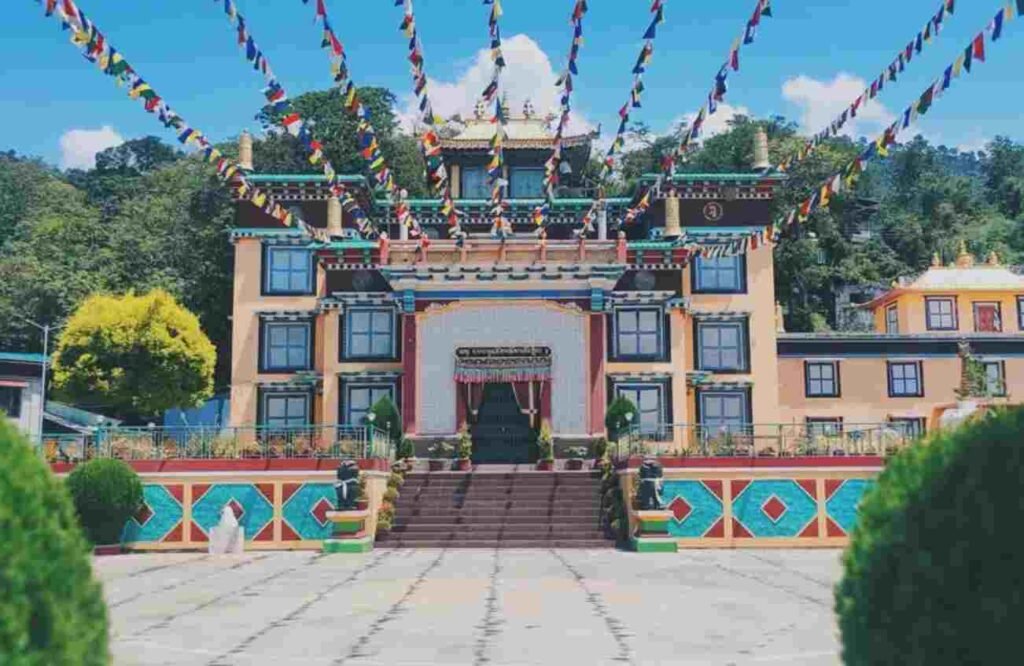
The Tibetan Buddhist monastery is situated at a distance of 8 km from Kangra Fort. It is a beautiful and peaceful place where you can learn about Tibetan culture and Buddhism.
Kangra Art Museum:

Located in Dharamshala, about 20 km from Kangra Fort, this museum houses a collection of Kangra paintings, miniature paintings, sculptures, and bronzes. The museum is a great place to learn about the rich cultural heritage of Himachal Pradesh.
Indrahar Pass:
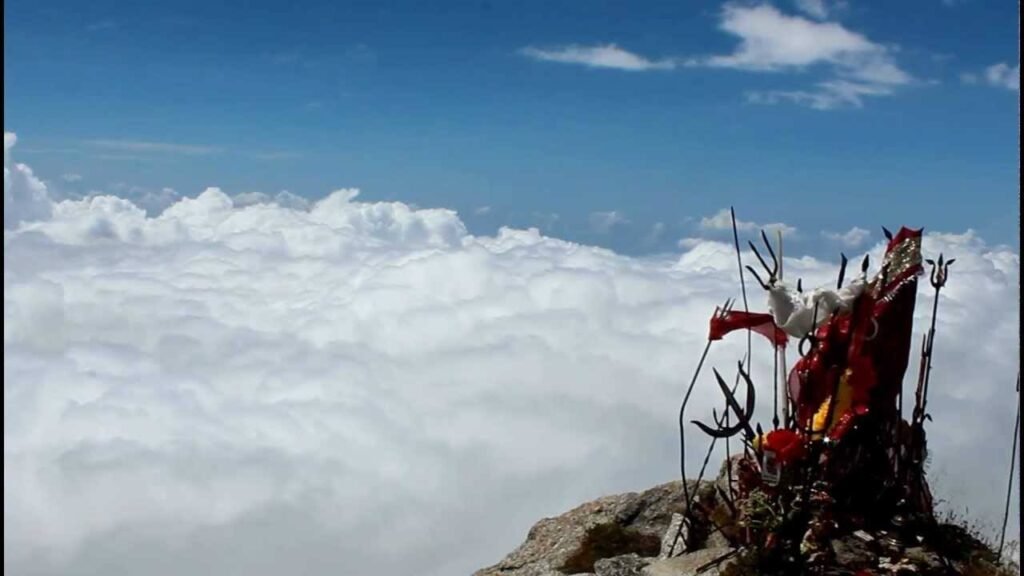
If you are looking for an adventure, you can go for a trek to the Indrahar Pass, which is located around 40 km from Kangra Fort. The trek offers stunning views of the Dhauladhar range and is a great way to experience the beauty of the Himalayas.
Frequently Asked Questions
Why is Kangra Fort famous for?
It is the largest fort in the Himalayas and probably the oldest dated fort in India.
Which Temple is Inside Kangra Fort?
There are three temples inside the fort called Ambika Devi Temple, the Shitlamata Temple and Lakshmi Narayan Temple.
Who was the King of Kangra Fort?
In 1774, the Sikh chieftain, Jai Singh, obtained the fort by stratagem, but relinquished it in 1785 to Sansar Chand, the legitimate Rajput prince of Kangra, to whom the State was thus restored about two centuries after its occupation by Akbar.
Who won Kangra Fort?
The fort was finally taken by the British during the First Anglo-Sikh war after a six-week long siege.
Why is it called Kangra?
Kangra district derives its name from Kangra town that was known as Nagarkot in ancient times. Kangra proper originally was a part of the ancient Trigarta (Jullundur), which comprises of the area lying between the river “Shatadroo” (probably Sutlej) and Ravi.
Follow Us on Facebook Page
